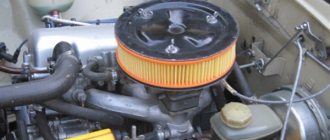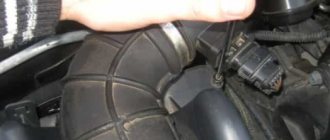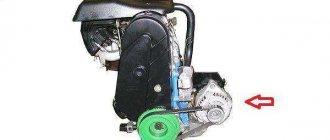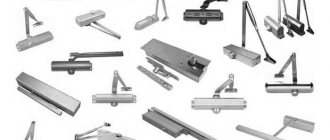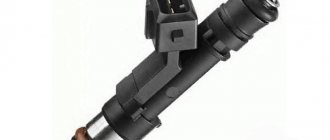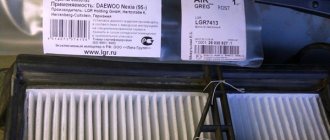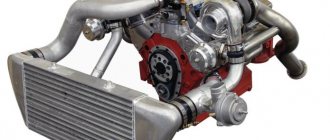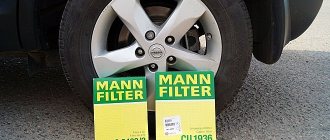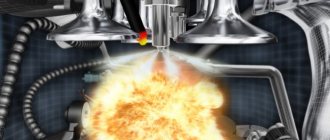In the early days of the automobile industry, engines constantly failed. A run of a hundred or two kilometers without repair was considered an achievement. The reason for this state of affairs was not so much the weakness of the design, but rather the lack of a fuel, air and oil purification system. Dust and decay particles entered the engine and increased the degree of abrasive wear. The situation changed in the 20s of the last century, when filter elements began to be used. The first was the Purolator oil filter (Pure Oil Later - clean oil at the outlet). The mileage between repairs began to amount to thousands of kilometers. Despite the fact that the automotive industry has stepped far forward, the life and reliability of the engine still depends on the quality of the oil filter.
Oil filter
Oil contamination in a running engine occurs continuously. Its intensity depends on many factors: engine design, fuel quality, operating modes and much more. Pollutants are usually divided into two main groups - organic and inorganic. Organic ones mainly consist of products of incomplete combustion of fuel, sulfur compounds, as well as products of thermal decomposition, oxidation, polymerization of oil and fuel. Inorganic impurities are dust, wear particles, technological contaminants and fragments of spent ash additives.
Oil contamination in diesel engines has its own characteristics - unlike gasoline and gas engines, the soot content is much higher. Its presence suppresses the anti-wear properties of oil additives and increases deposit formation.
At the same time, it would be wrong to assume that during operation the oil itself undergoes significant chemical changes that worsen its properties. In fact, there is an increase in the content of foreign substances in the oil, which causes it to age and need to be replaced. This is where a properly selected oil filter should play its role.
The main task of the filter is to protect and clean the oil circuit from impurities and decomposition products. Motor oil, in addition to lubrication, also cools and cleans the engine surfaces from wear products and incomplete combustion of fuel. A certain amount of dust enters the cylinders and through the air filter, depending on operating conditions and the condition of the air filter. The oil captures all contaminants and carries them into the engine sump, where it passes through the filter element. If there is no cleaning, the contaminants, turning into an abrasive, will kill the engine in a short time. During cold starts, peak pressure levels during frequent starting attempts, and during prolonged driving at high speeds, the oil filter provides lubrication through its own reservoir and the engine valve system. At increased loads, the bypass valve directs the oil flow bypassing the paper filter element. And the anti-drainage valve prevents oil from leaking into the engine crankcase.
Donaldson developments
As the world's largest investor in gas and liquid filtration research, Donaldson has developed a large number of revolutionary systems and materials throughout its history.
In Fig. 1 presents an innovative development from Donaldson - a new series of Power Core air cleaners for engines. PowerCore™ is a revolutionary technology that is completely different from traditional filters. It is based on the structure of the air filter filter element (see figure), consisting of parallel longitudinal channels separated by a membrane made of filter material and closed with polyurethane plugs on different sides. Thus, air supplied from the open side of the inlet channel rests against the plug at its end and passes through the membrane into parallel outlet channels closed by the plug on the inlet side. In this case, the material, unlike the standard membrane, is arranged in multilayers (in a roll).
As a result, the air filter has several times larger filtration surface with the same inlet cross-section. This dramatically increases the throughput and dirt holding capacity of the air filter, significantly reduces air flow resistance, or allows the filter to be more compact with the same characteristics, since there are no large volumes outside and inside the filter element necessary for the operation of a traditional air filter. An additional useful feature of the new material is the ability to create air filters of any shape (not just round), which gives special equipment designers more opportunities to improve ergonomics.
Additional benefits for Donaldson air filters come from the use of synthetic filter nanomaterials developed by the concern, created using Ultra-Web™ technology, developed and patented by Donaldson in 1995. These materials correct the main drawback of cellulose, the relatively large and unevenly distributed fibers of which with a diameter of 10...50 microns are poorly retained pollution particles less than 10 microns. At the same time, the material developed by Donaldson has a fiber size from 1 to 5 microns and a 2...5 times higher frequency per 1 cm2 with a high uniformity of distribution. In Fig. Figure 2 shows an image of materials made from cellulose (left) and synthetic microfibers (right) scaled to particles of 2 and 5 μm.
In air filters, layers of synthetic microfiber are used in combination with cellulose or other thicker synthetic fibers, which increases the overall strength of the filter material, as well as its dirt holding capacity due to the layered operation of the layers (large particles are retained at one level, small ones at another).
Compared to filter paper, the new material with a fiber diameter of less than 10 microns, developed by Donaldson, has a dust holding capacity approximately 2.4 times higher, is smaller in size, and has a cleaning efficiency of 99.99% versus 99.85% for a conventional filter. Air purifiers of the Power Core series are made entirely of plastic.
Donaldson's major innovative development is the pre-filter – monocyclone mod. TOP-SPIN. According to the company, the cyclone has the following characteristics: dust collection efficiency according to SAE ACCTD, depending on air flow, fluctuates around 85% of all dust and over 99% of heavy dust with a size of 20 microns or more, with an optimal resistance for these types of cleaners of the order of 200...250 mm. water Art.
Another modern Donaldson development is Strataclone cyclone pre-filters, designed primarily for commercial vehicles and providing a purification rate of up to 80%. The operation of such cyclone filters is based on the technology of active cyclone elements, the effectiveness of which does not depend on the spatial position. Moreover, the elements themselves can be assembled into packages of any size, configuration and capacity.
From 1993 to 1999, the Donaldson concern conducted operational studies of various machines with air cleaners made of different filter materials: filter paper, cellulose impregnated with special resins, and synthetics. The tests involved different types of vehicles - passenger cars, as well as light and medium-duty trucks. Tests were carried out in different conditions (city, highways, off-road routes, different weather conditions). Tests have shown that under all operating conditions considered, air purifiers with filter elements made of synthetic materials last longer. Under normal operating conditions, an air purifier can absorb from 2 to 4 g of dust per 100 km, and in high dust conditions - 3...5 times more. Operating conditions and even the composition of dust in the USA differ from those in Russia, so the test results can only be considered in general terms, without specific figures. Unfortunately, such large-scale and long-term tests of air purifiers have not been carried out in Russia.
Filter element
All modern oil filters are the same in design. They differ in manufacturing technology and materials. The main part of the oil filter is the filter element , which is made of special paper. Almost all the world's auto giants, as well as domestic car factories, trust filters made from paper from just two companies: the transnational company Hollingsworth Vose and the Italian Ahlstrom . In terms of quality, none of the domestic manufacturers can compete with these companies, and among foreign ones, only Japanese ones . Technologies for the production of modern filter paper are so knowledge-intensive and specific that they require investments of hundreds of millions of dollars and decades of experience in this field. It is hardly possible to ensure the appropriate quality of filter paper by building a plant somewhere in a Russian open field based on domestic, even the most advanced domestic developments. The costs are comparable to the construction of a car production line. Such a “monopoly” of quality is not accidental - filter paper must have a number of characteristics: a wide temperature range of operation, a certain degree of purification, completeness of screening, high strength, dust-holding ability, resistance to aging in the aggressive environment of hot oil and, of course, a high degree of purification. Papers from smaller companies that are too loose do not clean the oil properly and ultimately lead to accelerated engine wear. “Left” paper also does not have the required resistance to aggressive environments and does not provide stable operation over the stated service life, i.e. It can filter normally for 5000 kilometers, and then the dirt rushes into the engine through gusts. Therefore, the position of most automakers is quite clear: paper filters are either Hollingsworth & Vose or Ahlstrom . Others simply don't pass the test.
Filter design
There are three main types of filter designs: collapsible, non-removable and modular.
The classic, so to speak, textbook non-separable full-flow filter consists of a metal housing, a filter element and two valves: a bypass valve (sometimes called safety or bypass) and a return valve (other names are anti-drainage, anti-drain).
The bypass valve ensures that oil is supplied to the engine in cases where the filter element does not allow it to pass through. This happens if the element is dirty, as well as when the speed increases sharply or the oil thickens in the cold. The purpose of the check valve is to keep oil in the filter when the engine is not running in order to ensure a rapid rise in pressure in the system when the engine starts. Traditionally, the filter anti-drainage valve is made in the form of a rubber ring of variable cross-section, the elastic properties of which are lost over time. In this case, the oil is drained from the filter after the engine is stopped, and this is bad: upon subsequent start-up, there will be no pressure in the lubrication system until the filter is filled with oil again. This delay leads to increased wear of engine parts.
Some Russian and foreign filter manufacturers use an anti-drainage valve made in the form of a thin rubber disk. Its tight fit to the surface of the lid is ensured by a twisted or stamped metal spring. This design is characterized by increased durability. Another promising solution is to place a bypass valve at the top of the filter near the intake ports, which ensures that cleaner oil enters the engine when the valve opens. This type of design is used on some Purolator products.
The manufacturer, using conventional materials and technologies, always tries to choose the optimal balance of characteristics: strength, dust holding capacity, screening fineness and resistance level. The higher the degree of oil purification, the lower the screening fineness should be. However, a decrease in screening entails an increase in the resistance of the filter element and, as a consequence, an increase in wear. Nanotechnology radically solves this problem. A multilayer filter element that contains nanostructures allows you to retain the smallest particles without increasing resistance. In addition, the dust holding capacity and durability of the filter increases. Moreover, it is not just the retention of wear products and mineral particles, but the process of their oxidation and splitting. It has a positive effect on the structure and quality of the oil itself. The result is a “smart”, intelligent filter that has a huge resource and is able to work for a very long time without reducing its performance, for which a range of 100,000 kilometers is not fantastic. Of course, hardly any Russian enterprise will achieve a mileage of 100,000 km within a few years, but the production of filters from new materials consisting of cellulose and polyester compositions, the use of various impregnations and additives is a very promising area. New materials make it possible to achieve a service life of 30 to 50 thousand km, which corresponds to the standards for many new European passenger cars. This is not an easy task, given the fact that most domestic companies strive to reduce the cost of production and, as a rule, use the same so-called standard paper, even if produced under the same Hollingsworth & Vose brand. But for each type of engine you should use a certain type of paper with individual characteristics. As a result, the filter resource reaches a mileage of 15,000-20,000 km
Air cleaning
A modern internal combustion engine consumes approximately 50 to 4000 m3/h of air. Air dust content can vary from 0.001 g/m3 to 1 g/m3, and in particularly difficult operating conditions, for example, when tracked vehicles (tanks) move in a column, it can reach 2 g/m3. The filter should catch almost all of this dust. Mineral dust particles in the machine's environment can range in size from 0.1 to 200 microns. It has been established that 75% of the total mass of dust particles have sizes from 5 to 100 microns.
Abrasive particles entering a modern engine cause not only increased wear of parts, but also failures of auxiliary devices, such as sensors located at the air intake into the engine, electronic equipment, etc.
Technical requirements for air filters for domestic automotive vehicles are regulated by OST 37.001.622–2007, and their testing methods are regulated by GOST 8002. In foreign practice, filter performance is subject to agreement between the filter manufacturer and the consumer for each specific machine model.
Air purifiers for mobile vehicles, used for different levels of air dust, have different designs, for example, single-stage - for urban operating conditions of passenger cars and multi-stage - for agricultural, earth-moving, road machines operating in conditions of increased dust.
The service life of the air filter depends on the nature and volume of contaminants entering the air. So, if there is a lot of soot in the air, it will clog the filter element much faster than sand dust. A large percentage of moisture, small drops of water in the air, cause the filter paper to swell, which increases its resistance to air flow.
It is difficult to determine by eye how clogged the air filter is. Therefore, modern air filters are often equipped with clogging indicators, which indicate when the resistance at the filter inlet reaches approximately 635 mm. water Art. (remember that a new air filter usually has an inlet resistance of approximately 200 mm of water column). Indicators can be mechanical or electrical.
The efficiency of air purifiers is increased by using special filter materials, as well as by increasing the dust capacity per unit volume of the air purifier and by using pre-cleaners. This solves two problems: they extend the service life and service life of the filter, and also reduce its dimensions*. The latter is necessary because the constant increase in engine power leads to an increase in the volume of the air cleaner, which is increasingly difficult to place on the car.
The installation of cyclone-type pre-cleaner filters also helps to increase the service life of the filter, which is especially important in difficult operating conditions. Thus, in the laboratory of the Donaldson concern, tests were carried out on the effectiveness of various cyclone pre-filter systems, which gave the following results:
* It should be noted that the volume of the air cleaner cannot be reduced indefinitely: the wave tuning of the engine intake tract is disrupted, which reduces its filling and power.
| Cyclone pre-filter efficiency, % | Main air filter service life, % |
| 0 | 100 |
| 70 | 200 |
| 85 | 300 |
| 94 | 400 |
| 96 | 600 |
Realizing this, many manufacturers pay great attention to cyclone filters.
For example, Cummins Filtration has developed a stationary plastic impeller, which can be located outside or inside the air filter housing, spins the air entering the filter, from which large dust particles fall out under the influence of centrifugal forces. Cummins Filtration also developed the OptiAir filter element with increased dirt holding capacity.
A simple but quite effective design of a “dust ejector” is known, which is a nozzle at the entrance to the air intake, consisting of a series of tubes, inside of which spiral plates are installed. The air swirls inside the tubes, centrifugal forces throw large dust particles onto the walls of the tubes, then the dust pours out of the ejector and air partially cleared of dust enters the air duct. However, the ejector quickly becomes clogged, and this is its main drawback.
Sy-Klone International has developed a range of one, two and three stage precleaners. Precleaners of a similar design are produced under license by Caterpillar (CAT Turbine PreCleaner) and John Deere (Rotary Ejector). The design consists of a stationary impeller that spins the incoming air, from which coarse dust falls out under the influence of centrifugal force. Then the air enters the movable impeller, spins it to high speeds, and under the influence of centrifugal force, dust particles are thrown out through a vertical slot in the filter housing.
Champion Laboratories Inc. produces various filters under the Luber-finer brand. To purify the air, it has developed innovative technology and fiber material MicroGold Fiber Technology, which, according to the company, has a dirt holding capacity 50% higher than filters made from conventional materials, and a purification coefficient β = 99.97%. Luber-finer filter elements have an increased number of corrugations; the design includes special parts that strengthen the corrugations and tapes glued to the outside.
How to choose a filter
Firstly, on the quality of the filter housing. It must be durable, able to withstand pressure changes and resist corrosion so that oil does not leak during operation. The same qualities should be characteristic of the sealant. So, before purchasing an oil filter, it is advisable not only to read what is written on the packaging, but also to carefully examine the product itself to see if there is any corrosion, if everything fits tightly, etc. The role of valves is also significant, but their quality cannot be determined visually. It is also worth paying attention to the manufacturer's brand. Companies producing high-quality filters indicate the country of origin, exact address, and contact numbers. All kinds of “German quality”, “Made for EUROPE”, a reference only to sales representatives from European countries, when in fact the products are made in China, is nothing more than an attempt to mislead the consumer. There is another similar scheme for laundering the country of origin of a product: a certain company registers a new “brand”, for example, in France or Germany. She buys a batch of Chinese consumer goods, and then sells it to Russia, applying attractive “Europeanized” labeling. Additional guarantees of quality are also information about certification, the certifying organization and the quality management system used at the enterprise. The technological processes of all the world's leading manufacturers comply with the international quality standard ISO-9001. And among the bodies for certification of automobile products, the NAMI-Foundation, which works together with the Central Scientific Research Automobile and Automotive Institute (NAMI), has proven itself to be excellent. In Russia, the majority of car assembly line assemblers entrust the testing and certification of supplied auto components to this scientific and technical center.
Air filter
The concentration of dust on our roads is several times higher than on European roads - the content of particulate matter in the air ranges from 2 to 10 mg/cu. meter. Over a year of operation, the air filter of a car with a power of 100 l/s gets from 30 to 150 grams of dust. If there is insufficient filtration, dust ends up in the combustion chamber and in the oil. The result is accelerated wear of the piston group (up to 5-8 times faster than the installed life), as well as loss of power and increased fuel consumption.
The modern automobile industry, in an effort to reduce the cost of servicing new models, requires the manufacturer of consumable spare parts to significantly increase the service life - up to 50,000 kilometers or more. The air filter must maintain its characteristics when exposed to water, and be resistant to oil, fuel vapor, crankcase gases, and high (up to 90 ° C) temperatures. The durability and reliability of the air filter depends on the material of the filter element. Today, several types of materials are used - cellulose, impregnated cellulose, composite materials (layers of cellulose and synthetics), pure synthetics. Pure, cheap cellulose decomposes faster than others. The addition of 25% polyester increases the durability of the material five times. And 100% synthetics are 13 times more resistant to adverse environments than cellulose. The resource also depends on the area of the filter element. A square meter of the most common filter materials (cellulose and composite) can absorb from 200 to 300 grams of dust. Unscrupulous manufacturers skimp on the quality and quantity of filter materials. Or they claim a resource based on European dust standards, which are significantly lower than ours, due to the condition of roads and natural and climatic conditions. This is clearly misleading consumers.
An important characteristic of air filters is the resistance to air flow entering the engine. The higher the degree of air purification, the less porosity of the paper or non-woven material should be. For proper engine operation, the filter must allow no more than 1% of dust particles to pass through. However, the smaller the pores of the filter element, the faster they clog. Driving with a clogged air filter is like committing self-harm. Firstly, due to over-enrichment of the working mixture, fuel consumption increases and the dynamic properties of the engine deteriorate. Secondly, the filter element can rupture at any moment, since the areas of the element accessible for air passage experience several times greater load than usual. Where it is thin it will definitely break! And then all the dust will rush straight into the engine. It is obvious that achieving the optimal combination of the most important characteristics of a filter element - dust holding capacity, durability, porosity and flow resistance - is very difficult. Therefore, when purchasing an air filter, you should pay attention to the information about the filter material. It is desirable that it be produced by one of the well-known companies. Manufacturers of truly high-quality filter materials can be counted on the fingers of one hand. The largest is transnational, which is a supplier of materials and spare parts for such auto giants as Ford and General Motors, Caterpillar, as well as their subsidiaries. It was this company that was one of the few that managed to create synthetic filter elements that allow a resource of 100,000 kilometers to be achieved for both air and oil filters.
A low-quality air filter is a bit like a time bomb. You will discover the sad consequences only some time after its installation. For example, if the filter does not fit tightly to the housing or the filter element is made of a material with a large pore size, then the degree of filtration instead of the required 99% can be 60-70% and become fatal to the engine. This is especially true for filters from unknown manufacturers made from cheap non-woven materials. Just like low-quality filters, “reanimated” filters are also dangerous. Many craftsmen have adapted to cleaning, blowing and rinsing air vents. But don’t be fooled by the impeccable clean appearance – the filter life is limited by the physical properties of the filter element. In addition, it should be noted that operating a vehicle in difficult conditions requires more frequent filter replacement. It is possible to determine that “the time has come” by several indirect signs, such as increased fuel consumption, loss of power, difficulty starting the engine, increased CO2 content in the exhaust, etc. But it’s better not to let this happen and change the filter on time.
Engine air filter: operating principle and types of device
There is nothing superfluous or insignificant in a modern car. Even such an inexpensive and simple-looking element as an air filter is important, since the stable operation and overall technical life of the engine largely depends on it. How does the air filter work, and why must the requirements of technical regulations regarding the timing of its periodic replacement be strictly followed?
Purpose
The air filter is designed to clean the air entering the engine from dust, grains of sand and any other small and solid particles entering the engine. Atmospheric air is necessary for preparing the fuel mixture. When burning 1 liter of gasoline, up to 13 m² of air is consumed. All this volume flows through critical engine systems, including the intake and exhaust manifolds, the valve system and the cylinder chambers.
If the air entering the engine is not cleaned, the wear of rubbing parts will increase sharply, as a result of which the engine, even after a relatively short mileage, can completely fail. In addition to dust, which has abrasive properties, the “outboard” air contains another component harmful to engine parts - water vapor. When moisture gets on the metal, it provokes the formation of microscopic foci of corrosion. Rust particles are a powerful abrasive, so their presence in the engine is unacceptable.
The task of cleaning the air necessary for engine operation from dust and moisture is entirely assigned to the air filter. This unit successfully performs some other functions: it partially dampens the noise created by a running engine, and in carburetor systems it participates in maintaining the optimal temperature of the prepared fuel mixture. During the operation of the car, the air filter gradually becomes clogged, so it must be changed periodically.
Device, principle of operation
An air filter is usually called the entire assembly of incoming air purification. It is a housing with a removable cover, under which there is a filter element of a certain shape and design. The location of the air filter in the engine compartment depends on the engine type. So, in carburetor gasoline engines, this unit has a rounded appearance and is installed above the carburetor. Injection systems use more efficient rectangular filters.
To remove dust and other microscopic particulates from the air drawn into the engine, it is passed through a porous air filter material. Its design is made in such a way that the air entering the inlet can pass to the outlet only through the filter element. If the replacement filter is not installed carefully and the cover screws are not properly tightened, airflow will be able to pass through the gaps.
Types and composition of filter elements
During the evolution of automobile transport, the following various materials were used to purify the air entering the engine:
- Cotton fabric.
- Horsehair nets.
- Foam rubber.
- Fine bulk coal.
- Paper and cardboard.
- Pillows made of nylon fishing line.
- Containers with machine oil.
At the present stage, many of them are practically not used and have been replaced by more advanced porous compositions of paper and cardboard, which are better able to filter out harmful impurities.
Depending on the time of year and the area in which the car is operated, the filter must effectively cope with all undesirable components of the air environment:
- Road dust and sand.
- Vapors and drops of moisture.
- Cement particles and construction dust.
- Flower pollen.
- Components of urban smog.
- Small insects.
The basis of air filters for passenger cars are elements of various configurations made of paper, cardboard or microporous polymer materials. To prevent such filters from getting wet and preventing moisture from penetrating into the engine, they are impregnated with resinous substances. This processing method allows the filter material to trap even the smallest suspended particles of engine oil, antifreeze and other substances that may be present in the engine compartment.
Practice has shown that single-layer and single-component filters quickly become clogged. To improve operating efficiency and increase the service life of filter elements, new technologies for retaining dust and impurities have been developed.
First of all, this is a “deep” filtering method. It consists of using three layers of paper with pores of different sizes. The surface layer retains the largest particles, the middle one – smaller ones, and the third one completes the cleaning by letting absolutely clean air into the engine, slightly heated as a result of friction against the pores of the paper. Replaceable filtration elements can be manufactured in any size and spatial configuration, depending on the type of engine and the design of the filter housing.
Design features
The design and geometry of modern air filters are significantly influenced by the type, features of the design and operation of the engine, as well as the installation location of the unit in the engine compartment and the speed of the air flow entering it. The following types of filters are installed in cars:
- A round filter in the form of a ring , used in cars with a carburetor engine. In addition to the multilayer paper filling, these products are usually equipped with an aluminum mesh frame, which significantly increases their mechanical strength. This is necessary to protect the filter from deformation by the air flow. Elastic rubber or polymer seals are glued to the top and bottom of the filter ring.
- Panel filter element used in most diesel vehicles and injection engines. Available in framed and frameless versions. It features a larger air filtration area and overall efficiency. Panel filters take up less space and are quickly and accurately installed in the housing. To protect against deformation, they may contain reinforcing elements made of metal mesh or plastic.
- Cylindrical filters . Structurally they resemble ring elements, but are much taller and smaller in diameter. This solution made it possible to make the products more compact and at the same time increase the working area of the cylindrical filter element. They are used on trucks and a number of models of passenger cars with diesel engines.
In order to improve performance, the main filter elements can be supplemented with external pre-cleaning parts. Depending on this factor, there are:
- Products with one degree of filtration , made in the form of a dense accordion made of special paper and cardboard. Such filters quickly become clogged and are not protected from deformation, so they are rarely used in practice.
- Models with double filtration , the working surface of which is protected by a layer of porous synthetic material that performs the function of pre-cleaning the air from the largest particles of impurities. Filters of this design are recommended for SUVs and trucks operating in conditions with large accumulations of dust (at construction sites, in fields, quarries, etc.).
- Triple cleaning systems , characterized by the presence of a cyclone unit. At the initial stage, air enters the first compartment of the housing, where the flow is forced to swirl. Under the influence of inertial forces, most of the impurities are removed from it and sent to a storage container. The movement of air in a spiral can be organized due to the shape of the filter housing, or using an impeller driven by one of the pulleys.
Currently, many manufacturers have mastered the production of filters with so-called “zero resistance”. These products contain a multi-layer element consisting of oil-soaked fabric. Such filters effectively retain impurities and practically do not interfere with the intensive flow of air. Their disadvantage is the need for regular cleaning and maintenance, so most motorists prefer to use disposable filters of a standard design.
Operational issues
If a motorist uses only the type of air filter recommended by the manufacturer and replaces them as often as required by technical regulations, there is no need to worry about the quality of air entering the engine. Exceptions are cases when cars are systematically used on construction sites, for the removal of agricultural products from fields or quarryed minerals. When working in difficult conditions, filters need to be changed twice as often.
The terms recommended by experts for replacing filter elements are equal to the oil change period. It is at this point that it is customary to change both the fuel and air filters. Such a time reference allows you not to rely on the service book, especially since not all motorists keep it.
Failure to comply with the recommended installation times for new filter elements is fraught with the following consequences:
- Increased wear of engine rubbing parts.
- Problems with fuel injectors.
- Noticeable drop in power.
- Increased fuel consumption.
- Reduced engine life.
- Significant increase in repair costs.
Don't hesitate to replace the air filter. This is a simple operation for which it is not necessary to visit a service station. The steps to change the filter element are performed in the following order:
- Unscrew the fixing screws and carefully remove the air filter cover.
- Being careful not to allow accumulated dirt and dust to fall into the intake manifold, remove and set aside the old filter element.
- Clean and wipe the bottom of the housing with a cloth.
- Remove from packaging and carefully place the new filter in place.
- When installing the cover, make sure it is oriented correctly. In some motor models, two installation directions are possible, which correspond to the “Winter” or “Summer” risks. This is how the supply of cold “outboard” or heated warm air from the engine surface to the filter is regulated.
- Tighten the screws that secure the cover. Do not use excessive force to avoid stripping the threads.
Attention: owners of cars with a gasoline engine equipped with a carburetor should be especially careful when performing all operations to replace the filter element. This node is located directly below the filter. Experts recommend that after removing the cover, temporarily cover the carburetor with a clean rag. Because if dust or dirt particles get into the chamber, you will have to remove, disassemble and wash the entire assembly.
By following the timing and rules for replacing the air filter, you can avoid many problems associated with the need for early and quite costly engine overhaul.
Fuel filters
Fuel filters clean fuel from foreign impurities such as dust, rust, water and sediment in fuel tanks.
The fuel filtration system of a modern car consists of two or three, less often four, degrees of purification. The first degrees are coarse fuel filters that are installed in the fuel tank or immediately after it. Their task is to trap relatively large particles of pollution - over 60 microns, which can be seen by the human eye. But the most dangerous part of the pollution is particles from 15 to 50 microns. It is precisely these contaminants that fine fuel filters must cope with. Fine filters are either collapsible or non-dismountable. The design of the fuel filter depends on the type of engine for which it is intended.
Fine filters for carburetor internal combustion engines
The particle size that poses the greatest abrasive hazard for carburetor engines is 20 - 40 microns. Fine fuel filters for carburetor engines are either collapsible or non-removable. The first, which are now being used less and less, have a ceramic or mesh brass element that is used repeatedly. The second ones are non-separable, “disposable”, and have a paper, fabric or polymer filter element. Technical conditions provide for such filters to have a screening fineness of at least 15 microns, but most modern filters also retain smaller particles. For carburetor engines, it is considered sufficient if the fine filter at the beginning of operation retains at least 60% of the contamination. For paper filter elements, the paper used is the same as for oil filters. Some unscrupulous manufacturers use paper intended for air filters in fuel filters. Under the influence of gasoline, it becomes limp, and such a filter, as a rule, lasts two to three times less than it should. In addition, such paper cannot provide the required quality of fuel purification.
Injector filters
Injection engines are more demanding on the purity of gasoline - the fuel filter for the injection system must capture particles 10-15 microns in size. Another feature of injection engines is the relatively high pressure in the power system. Naturally, the filter installed after the electric fuel pump must withstand it with a reserve. Therefore, the fuel filter housing for injection systems is made of steel, aluminum alloy using welding (or a special kind of rolling of the end part) or especially durable plastic. As for the dimensions of the element, they depend on the engine displacement. The filter curtain is made of paper, which is laid in a “star” or in the form of a “spiral”. Spiral laying allows you to place 1.6-1.8 times more filter material and increase the resource. In addition, the contact time of the fuel with the filter element increases, which means a higher degree of nominal fuel purification is ensured. Filters with spiral folding may use not smooth, but crepe paper, which is capable of retaining a large amount of mechanical impurities. Some drivers, seduced by the beautiful metal body and large volume of injection fuel filters, try to install them on carburetor engines. This is a futile idea, since a weak diaphragm pump will not be able to cope with a filter designed to work with an electric high-pressure fuel pump. Therefore, the maximum filter resistance is reached very quickly, and the gasoline supply stops.
Video - Replacing the air filter Ford Focus 2
Any car enthusiast can replace the filter if he has a standard set of tools. To do this, it is not necessary to contact a specialized service and pay money for something that you can do with your own hands in a very short period of time. This will save money, which can be used to refuel the car.
First of all, you need to prepare the tools that will be needed when performing the work. These include: WD-40 lubricant and a long screwdriver with a head on the end.
To replace the zero gear, turn off the engine and let it cool. This is necessary to avoid burns. After this, unscrew the clamp that connects the filter and the adapter, remove the zero. Unscrew the adapter hose or tube that goes from the filter to the carburetor or injector and blow it out with a compressor. This will remove dust that has settled on the walls. Then reinstall the adapter hose or tube and tighten the mounting bolts or nuts. Install the new zero and tighten the clamp.
Procedure:
- Open the hood of the car and disconnect the battery terminal. It is recommended to perform this procedure every time repair work is carried out.
- Unscrew all the bolts that secure the air filter housing cover and remove the cover itself.
- Remove the old filter element from the housing. Try not to shake it or allow any other dust to enter it. Wipe the installation site for the new filter and lubricate its seat with pre-prepared lubricant.
- Install a new air filter. Be careful not to damage the filter element of the new filter.
- Put the cover in place and tighten all the fastening bolts.
After this, all that remains is to connect the battery terminal and continue operating the car. This completes the replacement of the air filter.
Fuel filters for diesel internal combustion engines
Diesel is also very demanding when it comes to fuel purity. The sizes of abrasive particles acceptable for a carburetor engine are simply unacceptable for it. One of the reasons for this sensitivity is the precision parts of the fuel equipment. Fuel cleaning in a diesel engine is carried out in several stages: preliminary in the fuel tank, coarse in coarse filters and final in fine filters. Fine filters can have replaceable elements or can be replaced complete with a housing, like their oil “colleagues”. “Diesel” filters differ significantly from gasoline filters. Firstly, they must be a reliable barrier that prevents water from entering the working volume - after all, its share in diesel fuel is about 0.2%. The second feature of the fuel filter for diesel engines is due to the properties of diesel fuel, which changes its properties as the temperature drops. Paraffins crystallize at low temperatures and can clog the filter, as well as damage the entire fuel system. To combat this phenomenon, heated filter elements are produced, for example, with a curtain made of conductive paper. Foreign designs of diesel filters sometimes include water presence sensors, water separation systems, and taps for draining sludge.
The arrangement of filters in diesel engines is usually as follows:
- installing a strainer in the fuel tank;
- installation of a sediment filter on the suction line;
- installation of a coarse filter and a fine filter in series with it on the low pressure line.
When should you change the filter? Abroad, a product with a spiral-pleated curtain is replaced every 70 thousand km. For our conditions, taking into account fuel contamination, the following figures are recommended: a filter with a spiral-fold arrangement should be changed after 40 thousand km, and a filter with a curtain laid in a “star” - after 24 thousand km.

